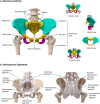Evolution of the reduction technique for unstable pelvic ring fractures: a narrative review
- PMID: 40287764
- PMCID: PMC12032693
- DOI: 10.1186/s40001-025-02570-y
Evolution of the reduction technique for unstable pelvic ring fractures: a narrative review
Abstract
Unstable pelvic ring fractures are associated with high mortality and morbidity, and the quality of reduction is critical to the prognosis. While previous reviews have examined general fracture reduction techniques, there is limited focus on the specific advancements and challenges in the reduction technique of unstable pelvic ring fractures. The pelvic fracture reduction technique has undergone a four-stage evolution: open reduction, conventional closed reduction, navigation-assisted closed reduction, and robot-assisted automatic closed reduction. This review discusses and compares the features, effectiveness, and safety of each reduction technique. Open reduction improves clinical outcomes compared to nonsurgical management; however, it is no longer commonly practiced due to its association with extensive soft tissue damage. Although conventional closed reduction is minimally invasive and reduces intraoperative blood loss, surgical duration, and the length of hospital stay, frequent fluoroscopy is required to assess the reduction position, imposing a high risk of radiation exposure. Computer-aided navigation technology has advanced closed reduction techniques by allowing better visualization of the fracture site and surgical instruments, thereby enhancing the quality of pelvic fracture reduction and reducing radiation exposure. The recently developed robot-assisted automatic reduction technique relieves the burden on orthopedic surgeons and further reduces intraoperative radiation exposure. Future advancements in the pelvic reduction technique may involve big data-based intelligent reduction to enable broader indications such as bilateral pelvic fractures.
Keywords: Effectiveness; Reduction technique; Safety; Unstable pelvic ring fracture.
© 2025. The Author(s).
Conflict of interest statement
Declarations. Ethics approval and consent to participate: This review does not involve human participants, human data or human tissue, ethics approval and consent to participate are not applicable. Consent for publication: This review does not include individual person’s data, consent for publication is not applicable. Competing interests: The authors declare no competing interests.
Figures


Similar articles
-
Intelligent robot-assisted minimally invasive reduction system for reduction of unstable pelvic fractures.Injury. 2023 Feb;54(2):604-614. doi: 10.1016/j.injury.2022.11.001. Epub 2022 Nov 4. Injury. 2023. PMID: 36371315 Review.
-
[Effectiveness of reduction robot combined with navigation robot-assisted minimally invasive treatment for Tile type B pelvic fractures].Zhongguo Xiu Fu Chong Jian Wai Ke Za Zhi. 2024 Aug 15;38(8):954-960. doi: 10.7507/1002-1892.202404049. Zhongguo Xiu Fu Chong Jian Wai Ke Za Zhi. 2024. PMID: 39175317 Free PMC article. Chinese.
-
Robot-assisted percutaneous screw placement combined with pelvic internal fixator for minimally invasive treatment of unstable pelvic ring fractures.Int J Med Robot. 2018 Oct;14(5):e1927. doi: 10.1002/rcs.1927. Epub 2018 Jun 19. Int J Med Robot. 2018. PMID: 29920914 Free PMC article.
-
Design and evaluation of an intelligent reduction robot system for the minimally invasive reduction in pelvic fractures.J Orthop Surg Res. 2022 Apr 4;17(1):205. doi: 10.1186/s13018-022-03089-2. J Orthop Surg Res. 2022. PMID: 35379278 Free PMC article.
-
2D versus 3D fluoroscopy-based navigation in posterior pelvic fixation: review of the literature on current technology.Int J Comput Assist Radiol Surg. 2017 Jan;12(1):69-76. doi: 10.1007/s11548-016-1465-5. Epub 2016 Aug 8. Int J Comput Assist Radiol Surg. 2017. PMID: 27503119 Review.
References
-
- Henderson RC. The long-term results of nonoperatively treated major pelvic disruptions. J Orthop Trauma. 1989;3(1):41–7. - PubMed
-
- Tornetta P 3rd, Matta JM. Outcome of operatively treated unstable posterior pelvic ring disruptions. Clin Orthop Relat Res. 1996;329:186–93. - PubMed
-
- Pohlemann T, Gänsslen A, Schellwald O, Culemann U, Tscherne H. Outcome evaluation after unstable injuries of the pelvic ring. Unfallchirurg. 1996;99(4):249–59. - PubMed
Publication types
MeSH terms
LinkOut - more resources
Full Text Sources
Medical

